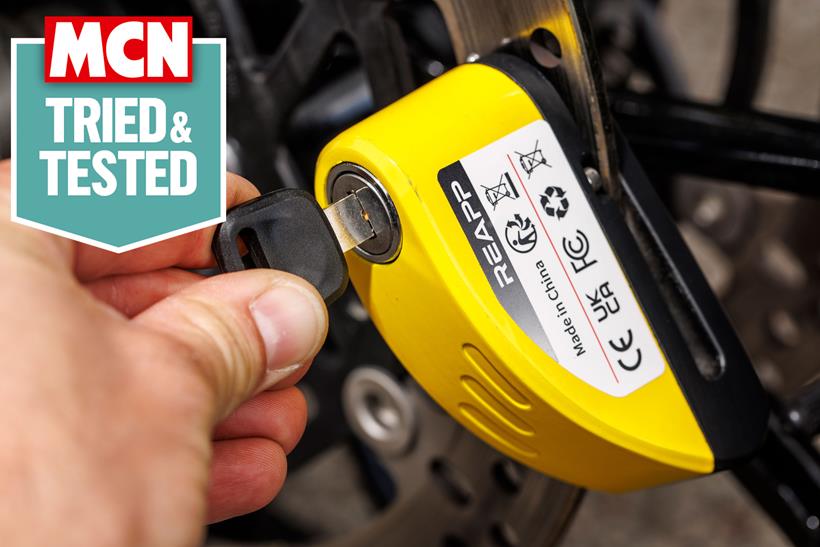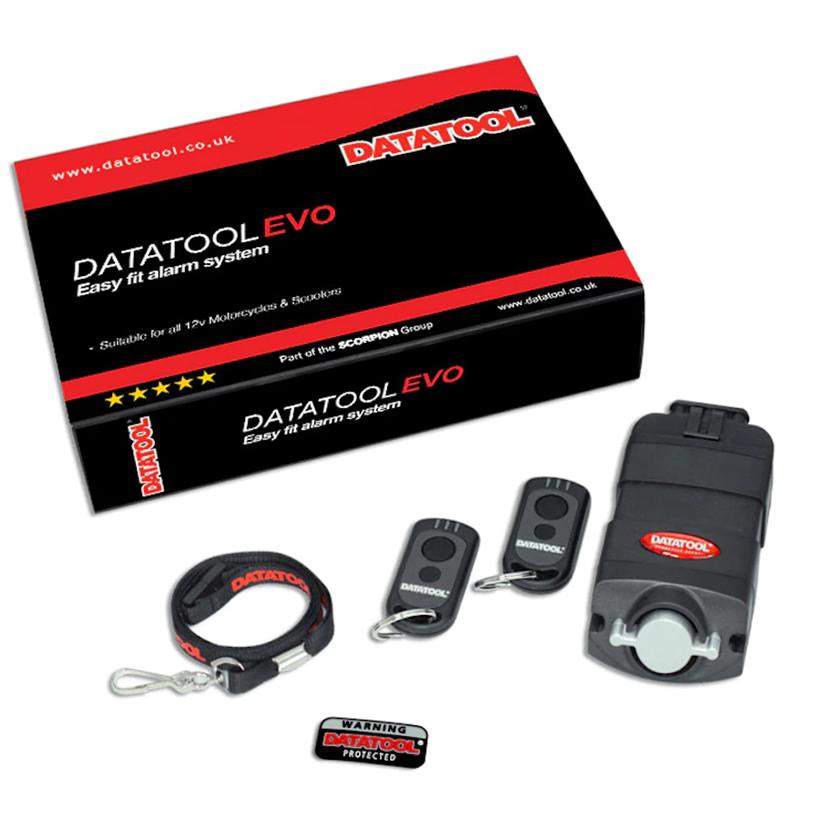Best motorcycle security with alarms, tested by MCN | The prime thief deterrent

We’ve said before that creating layers of security around your bike is key to helping prevent it from being stolen – and a motorbike alarm can be a great additional layer of motorbike security.
A disc lock will stop a thief from snapping the steering lock and pushing it away, either on foot or with an assist from an accomplice on another bike.
A chain and lock, particularly if secured to an immovable object like a ground anchor, will prevent this as well as several thieves picking the bike up and loading it into a van.
Jump to
- Why alarms are important
- Types of alarms for your bike
- What to look for
- Best alarmed motorcycle security
- Frequently asked questions
- How we test motorcycle alarms
Why alarms are important
Something else thieves dislike intensely is noise; they prefer to ply their trade in the dark and in silence so anything that creates a lot of noise as soon as they begin to attack a bike is a very good thing – it draws attention which is something they hate and hopefully, will make them give up and move on.
Types of alarms for your motorcycle
There are several forms of bike alarm; ones that are fitted to the bike and wired in permanently so they cannot be immobilised, standalone alarms that are taped or fitted to the bike with a strap, others that form part of another security device such as a padlock or disclock, when the siren sounds when they are tampered with.
An alarm to create attention if the bike is tampered with is a useful addition in your armoury of security devices – just make sure you choose (and set-up) one that is stable and doesn’t suffer false alarms or excessive battery drain, and you’ll be good to go.
What to look for in a motorcycle alarm
Motorcycle alarms act as a deterrent for thieves. Naturally, they do this by emitting a loud siren to draw attention to the crime. This hopefully scares the thieves away, or will at least alert your attention so that you’ll know to call the police. If you report the crime while it’s still in progress, it’s much more likely that you’ll get to see your ride again, so motorcycle alarms offer some great peace of mind for parking outside overnight, or when you’re grabbing something from the shops. There’s a few things to look for when you’re in the market for a motorcycle alarm, to give your ride the best protection possible.
One thing to look out for is the volume the siren rings at. The volume of an alarm is measured in decibels (dB), and as a rule should be at least 110dB to act as an effective deterrent. Also, check the kind of siren used. Some sirens are dual-tone, meaning the sound will be more noticeable and will carry further.
You should also consider the sensitivity of the movement sensor: the part of the alarm that detects whether your bike is being meddled with or not. Although you may not know how sensitive it is until it’s arrived at your door, it’s worth testing it before you trust it with your ride. Some alarms offer sensitivity adjustment, which is useful since different bikes will require a different level of sensitivity to be most effective without sounding false-alarms.
If it’s an alarmed disc lock, there’s some other considerations to make too. Check to see if it’s Sold Secure rated, since that should mean it offers stronger resistance to breakage, although it will often cost more as a result.
You may want to consider any extra features too. Alarms can offer some nice extra features for convenience, such as GPS ‘finding’ functions, and remote starting the bike. You can find some with extra security features too, like ignition cutoffs, additional LED visual deterrents, or sensitivity adjustment.
The best motorcycle security products with alarms, as tested by MCN
MCN Rated


"If you want something that looks like you’ve got a wheel clamp attached to your disc, then this probably isn’t for you – but if you want a highly portable tough and noisy disc lock that’s Sold Secure Motorcycle Gold standard certified, then read on."
"The XA14 is certainly compact, but it’s got the minerals to slow a thief down and if the light-fingered scumbag decides to have a good go at removing it, they’ll also have the 110dB siren to contend with while they meddle."
"The lock feels solid and well-made, is attractively bold in bright yellow (black also available), comes with three sturdy keys (and a key code in case you lose them all) that won’t bend in your pocket, and boasts a fat 14mm locking pin to keep it in place. Being small, it’s easy to slip into a tankbag, pannier or rucksack – although it’d be nice it if had its own little pouch to stow away in."
"You get a reminder cord, which I know from bitter experience should always be used, and the alarm battery is a USB rechargeable unit, so you don’t need to buy a box of button batteries with it and can even charge it while riding if you have a power point on your bike. Tidy bit of kit."
Pros
- Small
- High-security
- Loud!
Cons
- Looks weedy
- No carry-pouch
| Construction | Forged stainless steel |
| Alarm | 110dB siren |
| Size | 14mm locking pin |
| Charging | USB charging |
- 110dB alarm
- Sold Secure Gold
- Compact and portable
- 14mm locking pin
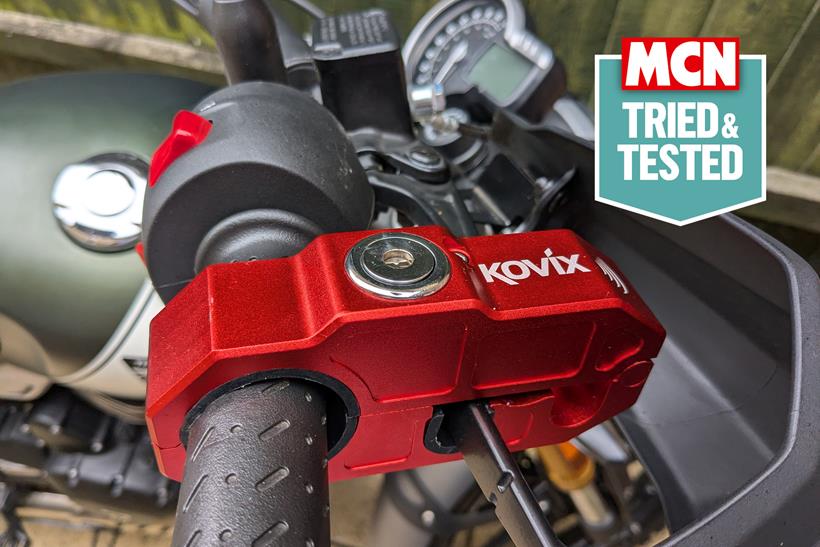

"On paper, this lever lock from Italian firm Kovix is a serious bit of kit. In a market filled predominantly with products made from plastic, the zinc/steel alloy Kovix immediately stands out as something a bit special and that’s before you get to the 120dB motion sensor alarm.
"When it arrived at MCN Towers I wasn’t disappointed, either. It tips the scales at 450g and that’s a reassuring heft, but it’s also got the feel of a properly made security device. If a criminal wanted to get it off your bike, they’d need a disc cutter and there’s not much in the security world that’ll resist one of those for long.
"Other nice features are the bracket for carrying the lock around on the bike (although I can't find anywhere to mount it on the Triumph Scrambler 400 X I'm currently riding) and a steel cable so you can use the Kovix to lock your helmet to the bike, too.
"The locking barrel is also located on the top of the body rather than the end, which means you can use it even if you have handguards fitted to your bike.
"I keep my bike outside and I've only had one false alarm trigger from the Kovix so far - and that was on an incredibly windy day where I think most motion-sensor products would have struggled.
"Even if the brake line was cut to avoid needing to remove the lock, the motion sensor alarm would still go off – and it makes a seriously unpleasant noise that would certainly attract attention. The only down sides are the rubber inserts for the throttle need a dab of glue to keep them in place and the high asking price."
Pros
- 120dB built-in alarm is seriously loud
- Top fastening for easy fitment (and works with hand guards)
- Alloy steel chassis rather than plastic
Cons
- You have to remember to check and change the battery
| Type | Alarmed lever lock |
| Construction | Zinc/steel alloy |
| Weight | 450g |
- 120dB alarm
- Alarm with automatic function
- Long battery life (about 10 months claimed)
- Waterproof
“You’ve probably not heard of Reapp – and nor had we until recently – but the deals on their disc locks are hard to ignore, especially in Amazon sale events.
“At full price, the Reapp costs £32.99 and for that money you’d probably go for a brand you’ve heard of like Oxford who have alarmed disc locks in this price range.
“But when it’s on offer at Amazon for as little as £23.99, it can look very tempting. So tempting, in fact, that we bought one.
“The first thing you notice as you take the lock out of the packaging is that it is incredibly light. The whole top casing is made of thin cast metal and is pretty much hollow apart from the alarm circuitry. It doesn’t fill you with confidence.
“The bottom section is made from solid metal but has such a cheap and scratchy finish that I initially thought it was made of plastic.
“It’s not all bad, though, as the alarm sound is genuinely ear-splitting. It’s high-pitched and very loud and would definitely demand attention if someone was trying to steal your bike.
“If you have a good-quality disc lock already without an alarm then the Reapp would make a good addition to your security armoury and it’s definitely better than nothing at all but if you have the budget there are better-quality options out there.”
Pros
- Very loud alarm feature
- It's a cheap option to add an alarm to your bike
Cons
- Flimsy construction
| Construction | Aluminium alloy |
| Alarm | 110dB siren |
| Size | 7mm lock pin |
| Weight | 420g |
- Waterproof
- Comes with a carry pouch
- Reminder cable included
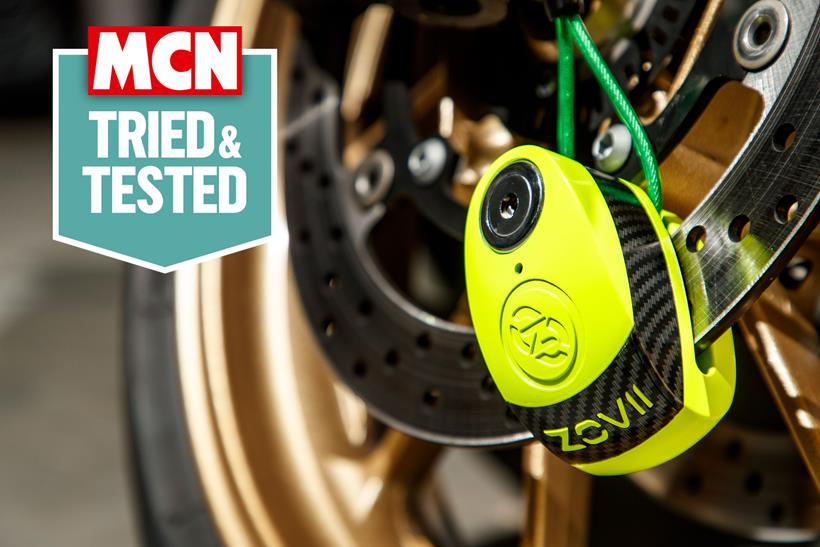

"The £59.99 ZD10 alarmed disc lock has a reassuring heft to it, yet it’s compact enough to fit into the pocket of my textiles without feeling too bulky. It has features like a carbide locking pin and full weatherproofing including against ice spray attacks, but one thing I really found neat was the way the battery installation works: I’ve criticised rival locks in the past for this, as quite often it’s a fiddly, irritating process, but here it’s simple – undo the grub screw (which isn’t accessible when on a disc, crucially) and the electrical assembly drops, allowing you to easily install it."
"I’m fully confident that not only will the alarm activate when either grip or disc lock is tampered with, but when it does it’ll be LOUD. The reason I know about the loudness is because when installing the batteries before using it, the locks emit a single 120dB beep that was so unexpectedly noisy I nearly fell off my chair."
"I’m a big fan of the bright colour, too. I’d far rather a thief was put off trying to steal my bike at a distance than getting up close before noticing the lock"
Pros
- Feels hefty and strong
- Alarm is very loud
- Compact enough to fit into a pocket
- Nice and bright to be seen by thieves
| Type | Alarmed disc lock |
| Locking pin size | 10mm |
| Alarm volume | 120dB |
- Corrosion resistant
- Waterproof electronics
- Double locking technology
- Easy push locking mechanism: locking without key by one push of the pin
But, if your bike doesn't have one installed already, this Evo version is a self-install model designed to be fitted by the user. It connects directly to the battery, utilising a movement sensor to detect unauthorised movement, and sound its alarm if it thinks your bike's being stolen. That includes detecting if the bike's engine is started, since it also monitors the battery's voltage. There is also a warning LED to provide an additional visual deterrent. It comes with two remote controls to arm and disarm it. You also get a 2 year warranty, and access to Datatool's 24/7 support team.
The movement sensor can be set to one of three modes with the remote, to adjust the sensitivity to your preference. There are switchable chips for arming and disarming (not permitted in the UK), and there is also a transport mode so the bike can be transported safely without the alarm being triggered. You can opt for an extra seat trigger, in case thieves try to remove the seat pad to access the bike.
You'd expect a higher price with this many features and their reputation behind them, but the Datatool Evo still offers compelling value at its RRP
Pros
- Easy to fit
- Range of useful features
- Great value
Cons
- None we can think of
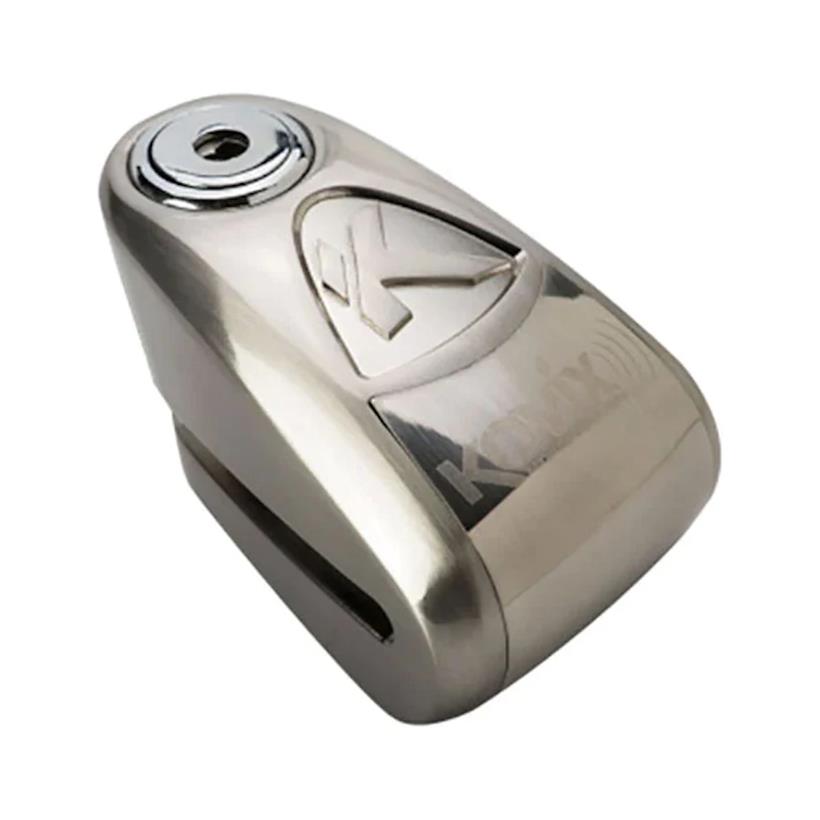

The waterproofing is a nice feature, achieved by weatherproofing the electronic circuitry inside, and the battery life is said to be 'long', supplied from an internal lithium cell. Its small size means you can easily pocket it too, even if its high quality materials give it a hefty weight, and it might be more comfortable to let your bike do the carrying for you.
The alarm function can be turned off in this unit, for the rare instance where the alarm going off could cause more harm than good.
Overall you are paying more for the brand name and high quality materials, but those do hold a lot of weight for security products. Failure is not an option when it could cost you your ride, and this will certainly act as a reliable first line of defence to keep thieves away.
Pros
- Physical deterrent
- Use with or without alarm
- Waterproof
Cons
- Needs carrying somehow
Frequently asked questions
Why is an alarm effective?
As mentioned above, thieves hate having attention drawn to them, so the loud siren of an alarm that has been disturbed will likely send them running before anyone can call the police on them or intervene.
Will an alarm drain my battery while my bike is parked up?
There will often be a small drain on the battery from an alarm that is wired into the bike, but it will take several days to drain a healthy battery to a point where it will not start. Some alarms will have their own battery power source, especially things that are removable from the bike and require charging. To avoid battery drain it’s best to look after your battery with an optimiser or trickle charger.
Can I fit an alarm myself to my bike?
It really depends on your level of expertise. Fitting an alarm to a motorcycle will involve a good understanding of wiring and electronics. So the likelihood is that if you are unsure if you know how to then it may be safer to take it to an expert and pay have to have it done properly.
How MCN tests alarmed security products
At MCN, our team of expert journalists have decades of experience gained over hundreds of thousands of miles in order to provide you with opinions and evaluations you can trust, alongside news of the most significant developments in motorcycling safety gear. We want you to stay safe, enjoy your riding and hopefully look great while doing so!
We don’t test our kit to destruction; we use it exactly how you do, in the real world and in all conditions.
That means we can deliver impartial buying advice you can rely on. To make it onto this list, alarms must have been used for hundred or thousands of miles or several months by our team of experienced testers, show no major flaws, and meet modern safety standards as well as offering decent value for money.
Each of our expert reviewers tests alarmed security to a set of criteria, both subjective and objective, including how they fit, the alarm’s volume (if fitted), whether there’s a tether, how easy the battery is to replace, what the packaging is like and how easy it is to carry with you on a ride out.
We also regularly compare them with one another in the office, so collectively we’ve built the sort of knowledge base you can trust.
If you can’t see a review against an alarm on this page, it’s because we haven’t tested it yet. These will only be included if we think they’re important and relevant in the market, and rest assured, we will be working on bringing you a review as soon as we’ve done the miles.
Here’s a brief run-down of the star rating system we use, and what each score means:
- 1 star – Poor performance in this category or overall. A product with a single star rating has fallen below the expected standard and should be avoided.
- 2 stars – Basic performance in this area or overall. A product with a two-star rating has managed to perform to a barely acceptable level and there is room for improvement.
- 3 stars – An average performance in this area or overall. A product with a three-star rating has achieved a basic level of performance and is deemed adequate.
- 4 stars – A product has performed over and above the accepted averaged in this category or overall. A product with a four-star rating has surpassed expectation and delivered in a particularly impressive way.
- 5 stars – A product has performed at the highest possible level in a particular category or overall. A product with a five-star rating has delivered to the highest possible level, impressing the tester with its performance. We would happily spend our own money on it.
To find out more, head to our dedicated page explaining how we test motorcycle products.
– Just so you know, whilst we may receive a commission or other compensation from the links on this page, we never allow this to influence product selections – read why you should trust us.
- Just so you know, we may receive a commission or other compensation from the links on this website - read why you should trust us.
